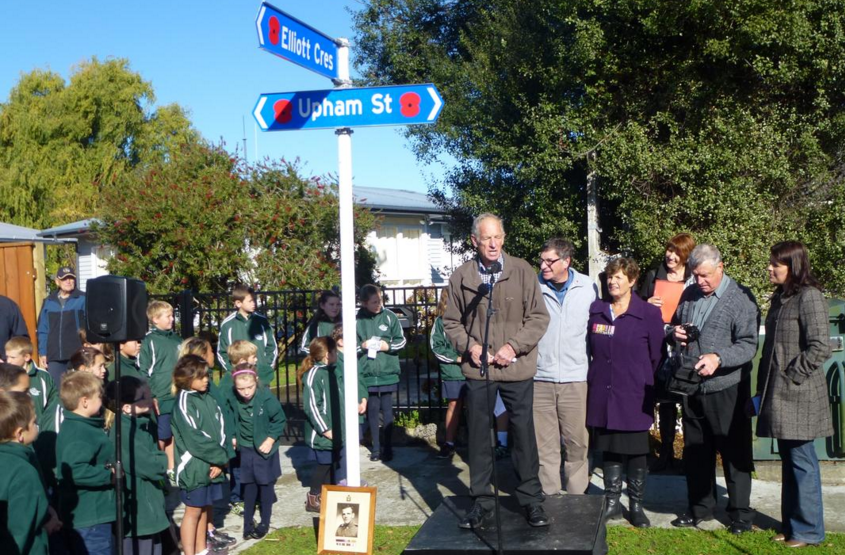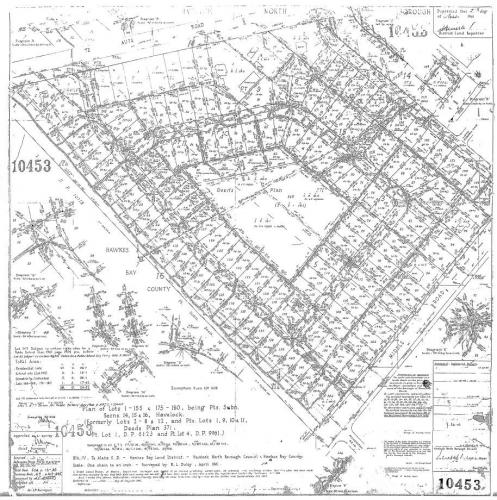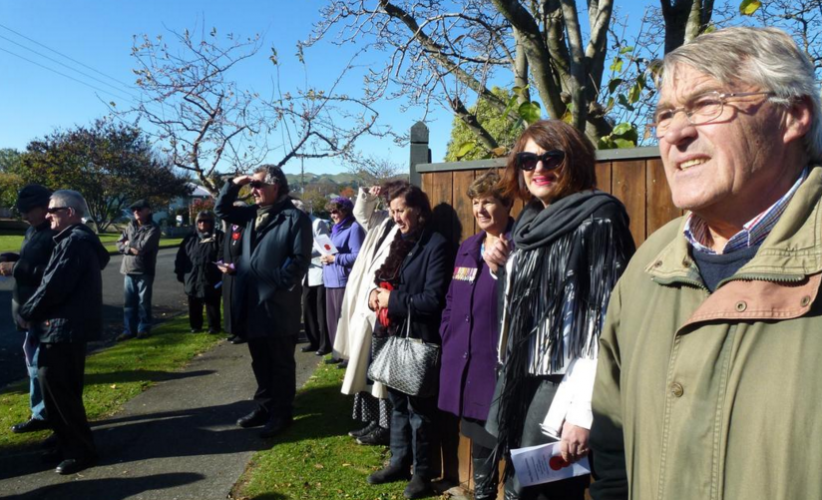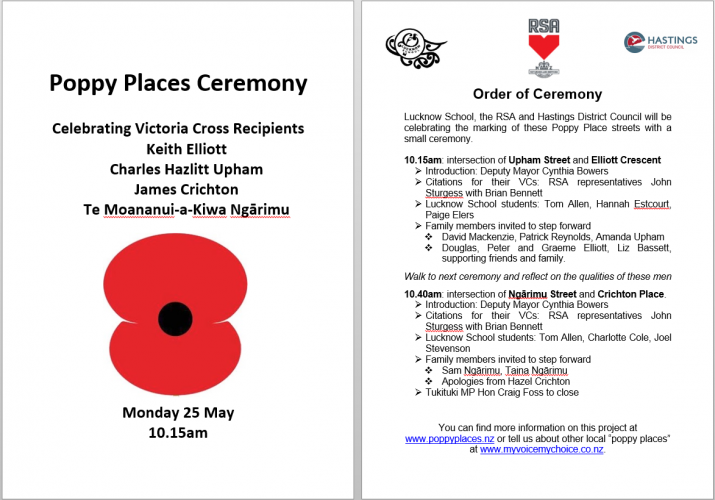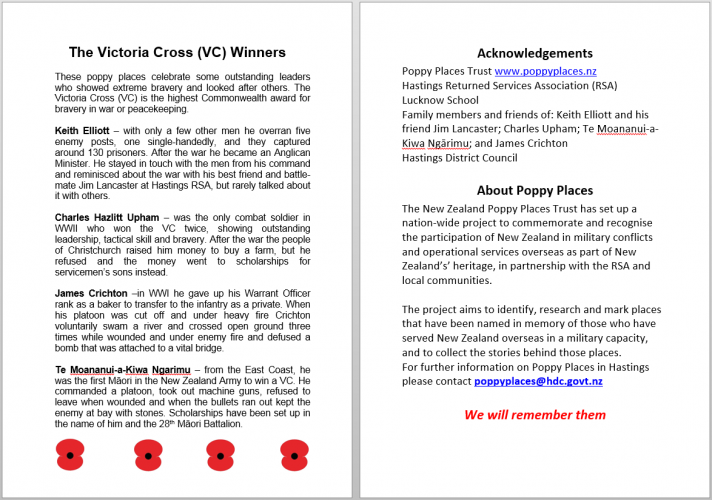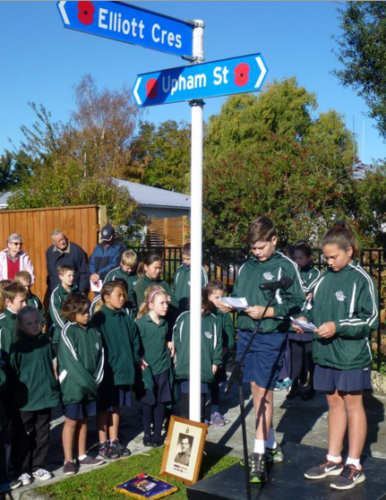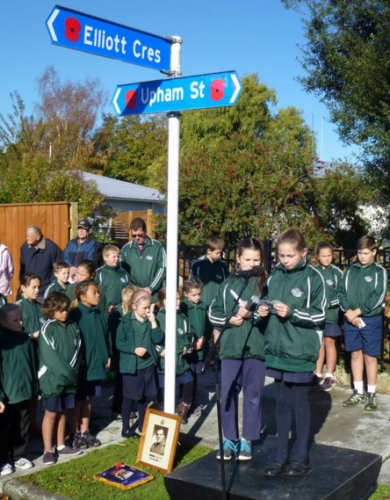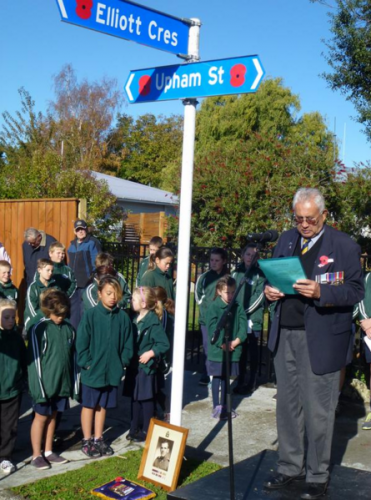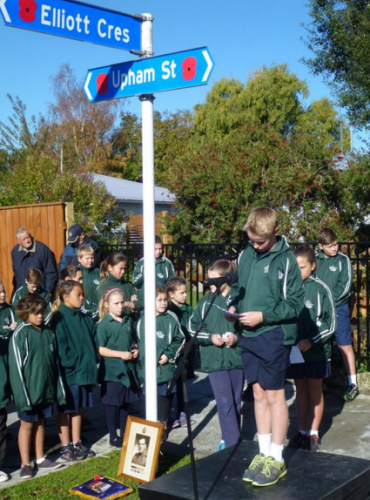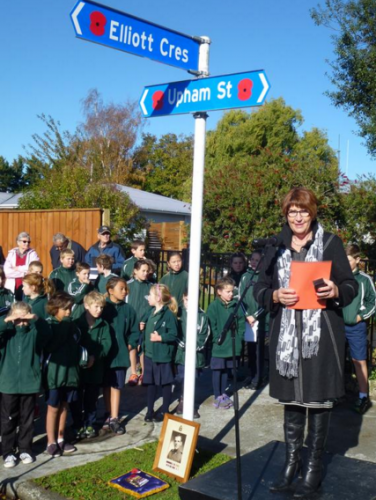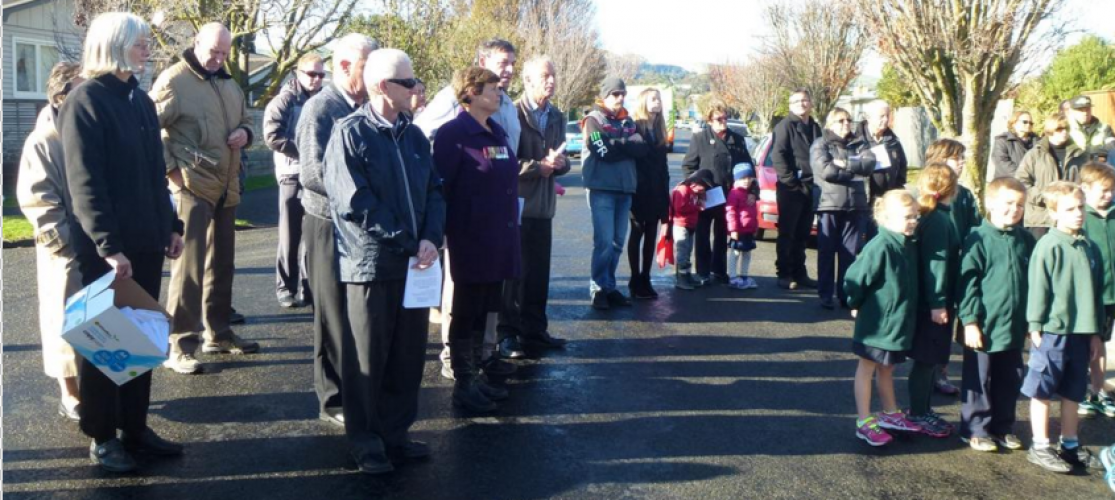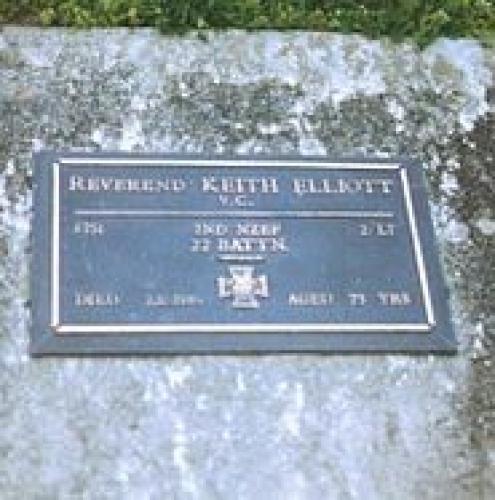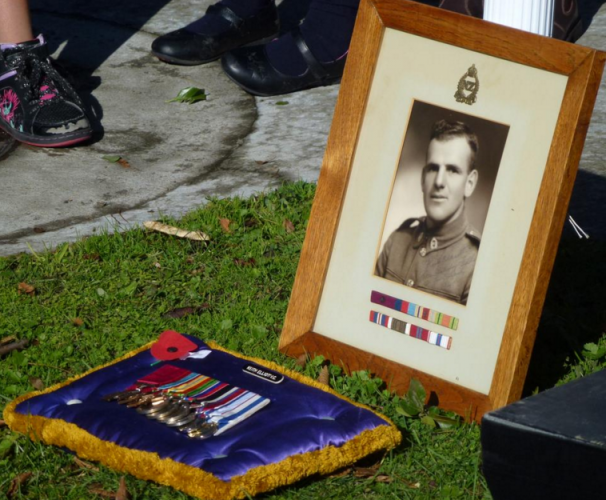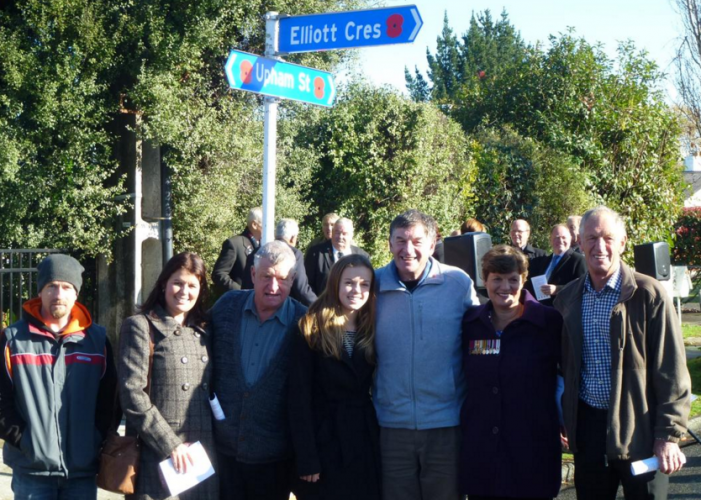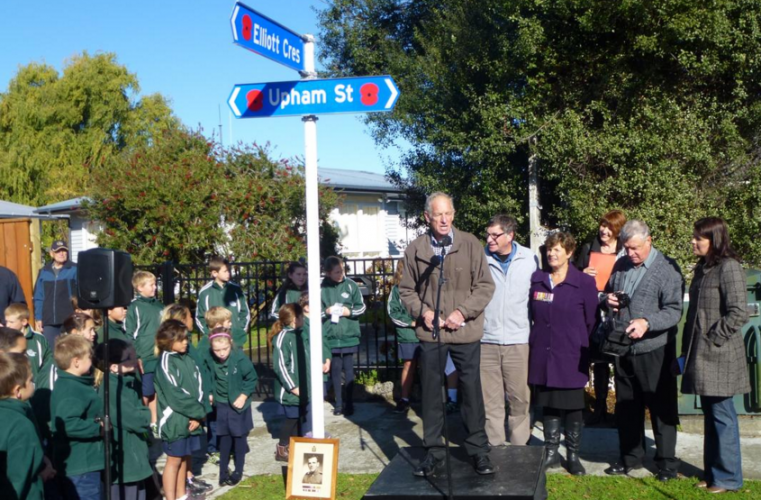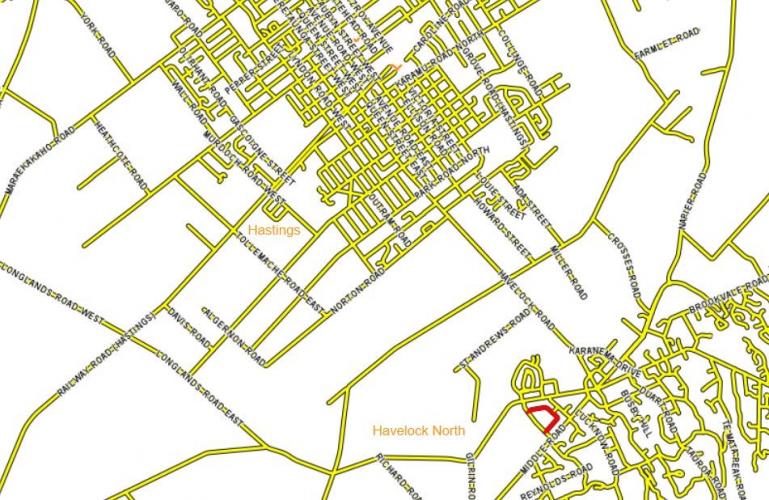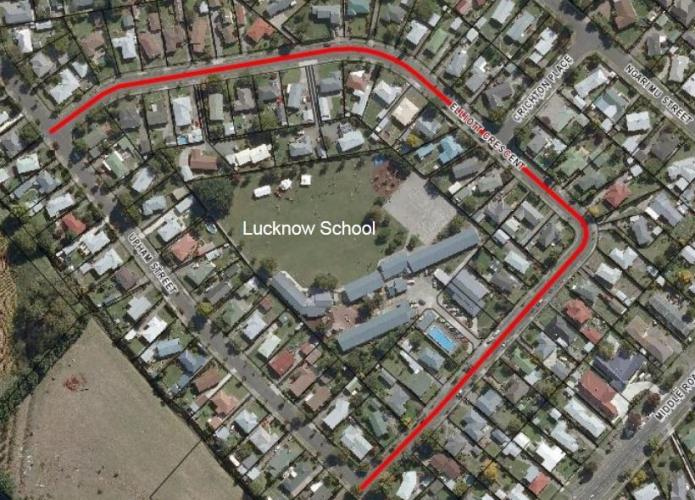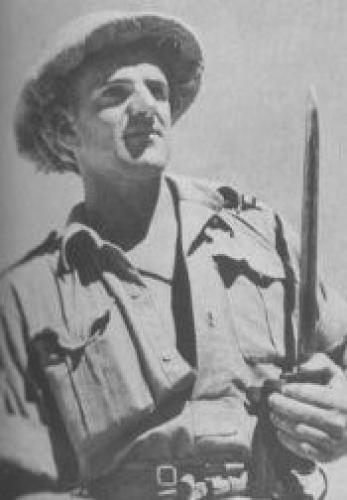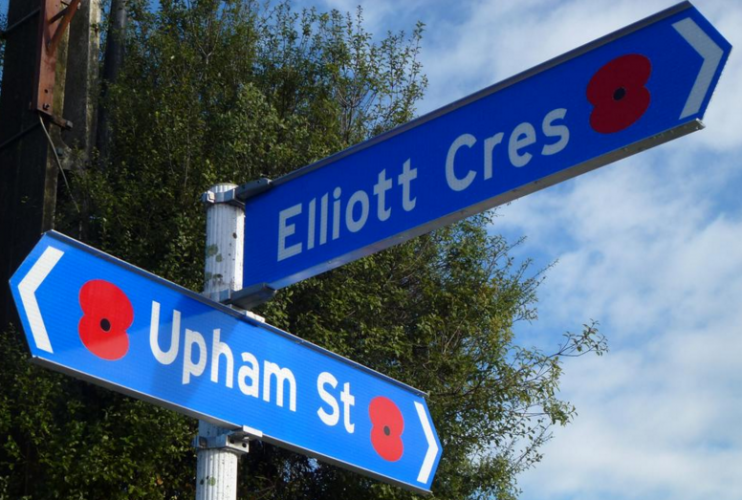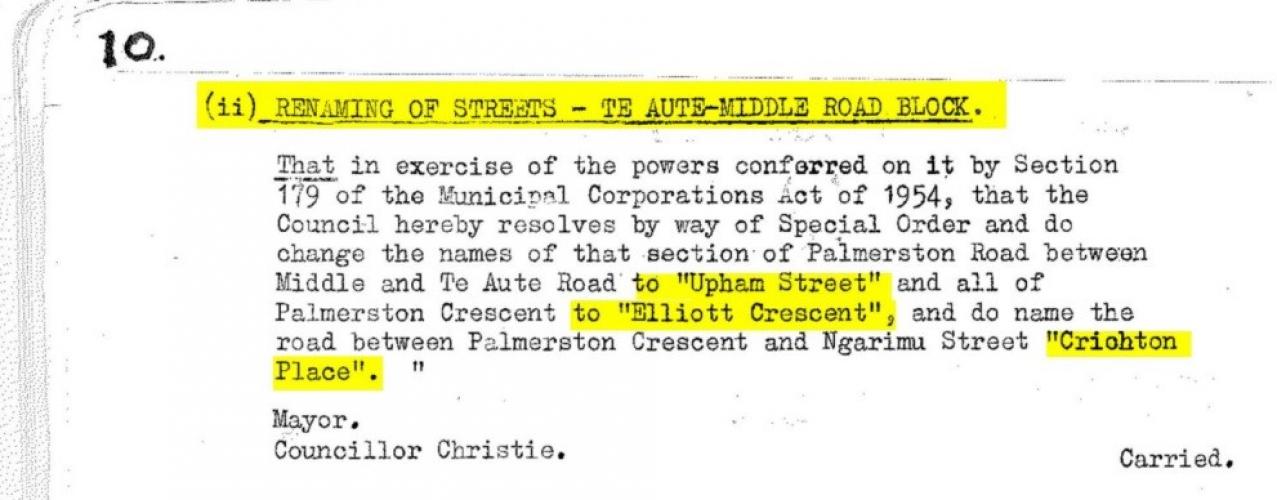049 Elliot St Hastings, New poppy place sign posts
Reason for the name
Elliott Crescent is one of four adjoining streets in the Anderson Park suburb in Havelock North named, in 1961, after Victoria Cross winners.
While the Council minutes do not show the discussion or reasons, there is a high degree of confidence that this street was named after Victoria Cross (VC) Winner Keith Elliott, who had ties to the Hawke’s Bay and lived in Hastings.
Adjoining roads were named at the same time after VC winners Charles Upham and James Crichton, and four months earlier the neighbouring Ngarimu Street had been named (reference to VC Winner Te Moananui-a-Kiwa Ngārimu).
Authors: John Stables, RSA, John and Sandy Lancaster, Neil Chambers, Helen Gelletly, Cherie Flintoff, Madelon van Zijll de Jong (HDC), Katrina Barrett (Stoneycroft)
Keith Elliott was born on 25 April 1916 at Apiti, in the Manawatu, the eighth of nine children of Thomas Frank Capper Elliott, a farmer, and his wife, Ethel Marie Knyvett.
After attending Feilding Agricultural College, Elliott was managing his father’s farm near Fielding. When World War II began he immediately joined the New Zealand Expeditionary Force.
An extract from 22 Battalion (reference below). The Battalion was largely overrun, when they had been ordered forward, inadvertently passing eight German tanks that then came up on them from the rear. They were in a poor defensive position and hadn’t had time to properly dig in, and when the tanks first appeared thought they were the promised British armour. Both 10 and 12 Platoon were captured. Elliott realised what was happening and ordered 11 platoon to a safer position, from where he and a few others led some spirited offensive actions.
… One platoon on our right that was near a bit of a ridge got up and made a run for it, they had of course to run a hell of a gauntlet of machine-gun bullets, and it was pretty grim to see these men running with dust being kicked up all round them as they fell or dived to the ground and then up and on again.’ These were Keith Elliott and his men, and as they began running men shouted: ‘What the hell are you running for—they are our tanks.’
‘The tanks having knocked out our guns came rumbling and clanking towards us with nothing to stop them…. We could do nothing but keep hoping some of our own tanks would turn up to the rescue…. Now the sudden bewilderment was ending, many a man realised and continued to realise bitterly that ‘It was a humiliating and disgusting sight. Someone somewhere had let us down badly.’ …As the captives trudged off through the dust, the sun came over the horizon.
On a slight rise on the far right flank of the battalion 11 Platoon, commanded by Sergeant Keith Elliott, saw four tanks swinging round to the east. Infantry were running behind them, and about the time when the startled onlookers began identifying white crosses on the tanks, the firing started. Elliott, although wounded across the chest, cried out to his platoon to move 400 yards ahead to the semi-cover of a slight ridge.11 Swiftly the three sections (led respectively by Corporals Garmonsway, 12 West13 and Staines14), eighteen men in all, reached cover in time to see the four tanks close in from the east on 12 and 10 Platoons and march them off at a smart clip to the west.
Moving another 400 yards north to a second small ridge, the platoon saw New Zealand troops and, after Elliott's chest wound had been dressed, took up a position on their far right (eastern) flank. Here the platoon came under the command of Lieutenant Shaw15 of 21 Battalion. A distressed lance-corporal appeared and said that his officer and batman were lying out in front, the officer with an eye shot out and bleeding badly. Elliott, leaving Corporal West in position, went out with Garmonsway's and Staines's sections. They were soon under fire from a post about 500 yards ahead, and Garmonsway on the right flank was held up by more firing from the east. Elliott ordered Garmonsway to press home an attack in that direction.
Elliott now began his own attack ahead, the first of a series of charges which won the Victoria Cross, five enemy strong points and some eighty prisoners. With the sergeant were only three men (everyone else was more than fully occupied as it was): Lancaster 16 Jones 17 and Smith.18 As they closed in to within 50 yards of the first post ahead, the eleven Italian defenders signalled surrender. While they were dismantling an anti-tank gun and some machine guns, they were fired on by another post 100 yards directly ahead and from yet another a little to the right and further on. Smith was now sent back for reinforcements. Elliott, Lancaster, and Jones captured the next two posts ‘fairly easily’. The three men now had about fifty prisoners. They set about dismantling and wrecking more enemy weapons.
However, from the north-west, from a gently rising slope, fresh fire was directed at them. Shepherding their prisoners again with them, the three New Zealanders advanced against this fourth post over 100 yards away. The attack was well under way when another stream of fire burst from yet another direction, from behind and from the west about 200 yards away.
Leaving Lancaster and Jones to attend to matters in front, Elliott on his own dashed towards the new threat from the west, but was forced into cover alongside an abandoned water truck. From there he sniped at the defenders until all were on the point of surrender, except the machine-gunner who, sticking to his gun and keeping the deserted truck under fire, succeeded in wounding Elliott in the thigh. Elliott recovered from the shock of this wound in time to see a sniper on the escarpment hampering Jones and Lancaster. He fired at and winged this sniper, and then, turning to his own pressing problems, dashed to a small hummock, threw a grenade and charged, eliminating the machine gun and its faithful operator and taking about fifteen prisoners.
Weak from his wounds (another bullet had creased his knee— his third wound—and furthermore he was fresh from hospital after a bout of malaria), Elliott re-joined Jones (now wounded) and Lancaster in time to help wipe out the fifth and final post. With their captives (including two German medical officers and several German other ranks) they made their way back slowly to Corporal West's position, where Garmonsway and his party, in a spirited second front of their own which won Garmonsway the DCM, had silenced three machine-gun nests and taken a German officer and a sergeant, two Italian officers and sixty Italian other ranks. By noon 11 Platoon's tally was 140 prisoners and perhaps thirty killed and wounded.
Indian troops were now spreading out over ground ahead. Elliott was taken away to an Indian dressing station.
Since Victoria Cross holders were considered good for morale back home, Elliott, in spite of his protests, was returned to New Zealand. Keith Elliott married Margaret Markham, who he had met before the war, in 1944. They had five children together, Doug, Graeme, Peter, Mary and Elizabeth.
In 1947 was ordained a minister in the Anglican Church. He served as Vicar in a number of parishes including working for many years in the Māori Mission before moving to Wellington as the Assistant City Missioner and later as Welfare Officer for the Fire Service.
After a lifetime of committed service in both the military and the Church, Keith Elliott died in 1989, at Wellington, aged 73.
Local Hastings RSA member, John Stables, reminisced about how Keith Elliott frequently used to come to the RSA to drink and talk with his old friend Jim Lancaster, and that Keith often told Jim that he should have been the one to get the VC. Jim (Shorty) Lancaster was one of three men with Keith Elliott during the action for which Keith won the VC. His respect and ongoing support for those he had fought with was enduring.
Keith Elliott’s VC Citation
At dawn on 15 July 1942 the battalion to which Sergeant Elliot belonged was attacked on three flanks by tanks. Under heavy tank, machine-gun and shell fire, Sergeant Elliott led the platoon he was commanding to the cover of a ridge three hundred yards away, during which he sustained a chest wound. Here he re-formed his men and led them to a dominating ridge a further five hundred yards away, where they came under heavy enemy machine-gun and mortar fire.
He located enemy machine-gun posts to his front and right flank, and while one section attacked on the right flank, Sergeant Elliott led seven men in a bayonet charge across five hundred yards of open ground in the face of heavy fire and captured four enemy machine-gun posts and an anti-tank gun, killing a number of the enemy and taking fifty prisoners.
His section then came under fire from a machine-gun post on the left flank. He immediately charged this post single-handed and succeeded in capturing it, killing several of the enemy and taking fifteen prisoners.
During these two assaults he sustained three more wounds in the back and legs. Although badly wounded in four places, Sergeant Elliott refused to leave his men until he had reformed them, handed over his prisoners, which were now increased to one hundred and thirty, and arranged for his men to re-join the battalion.
Owing to Sergeant Elliott's quick grasp of the situation, great personal courage and leadership, nineteen men, who were the only survivors of B Company of his battalion, captured and destroyed five machine-guns, one anti-tank gun, killed a great number of the enemy and captured one hundred and thirty prisoners. Sergeant Elliott sustained only one casualty amongst his men, and brought him back to the nearest advanced dressing station.


